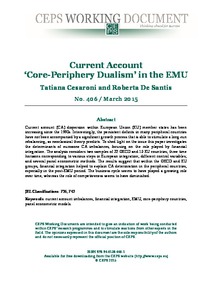Current account ‘core-periphery dualism’ in the EMU
"Current account dispersion within EU member states has been increasing since the 1990s. Interestingly, the persistent deficits in many peripheral countries have not been accompanied by a significant growth process that is able to stimulate a long-run rebalancing, as neoclassical theory predict...
| Main Authors: | , |
|---|---|
| Institution: | ETUI-European Trade Union Institute |
| Format: | TEXT |
| Language: | English |
| Published: |
Brussels
2015
CEPS |
| Subjects: | |
| Online Access: | https://www.labourline.org/KENTIKA-19113366124919315489-Current-account-‘core-peripher.htm |
| Summary: | "Current account dispersion within EU member states has been increasing since the 1990s. Interestingly, the persistent deficits in many peripheral countries have not been accompanied by a significant growth process that is able to stimulate a long-run rebalancing, as neoclassical theory predicts. To shed light on the issue this paper investigates the determinants of eurozone current account imbalances, focusing on the role played by financial integration. The analysis considers two samples of 22 OECD and 15 EU countries; three time horizons corresponding to various steps in European integration; different control variables; and several panel econometric methods. The results suggest that within the OECD and EU groups, financial integration helped to explain CA deterioration in the peripheral countries, especially in the post-EMU period. The business cycle seems to have played a growing role over time, whereas the role of competiveness seems to have diminished." |
|---|---|
| Physical Description: | 30 p. Digital |

